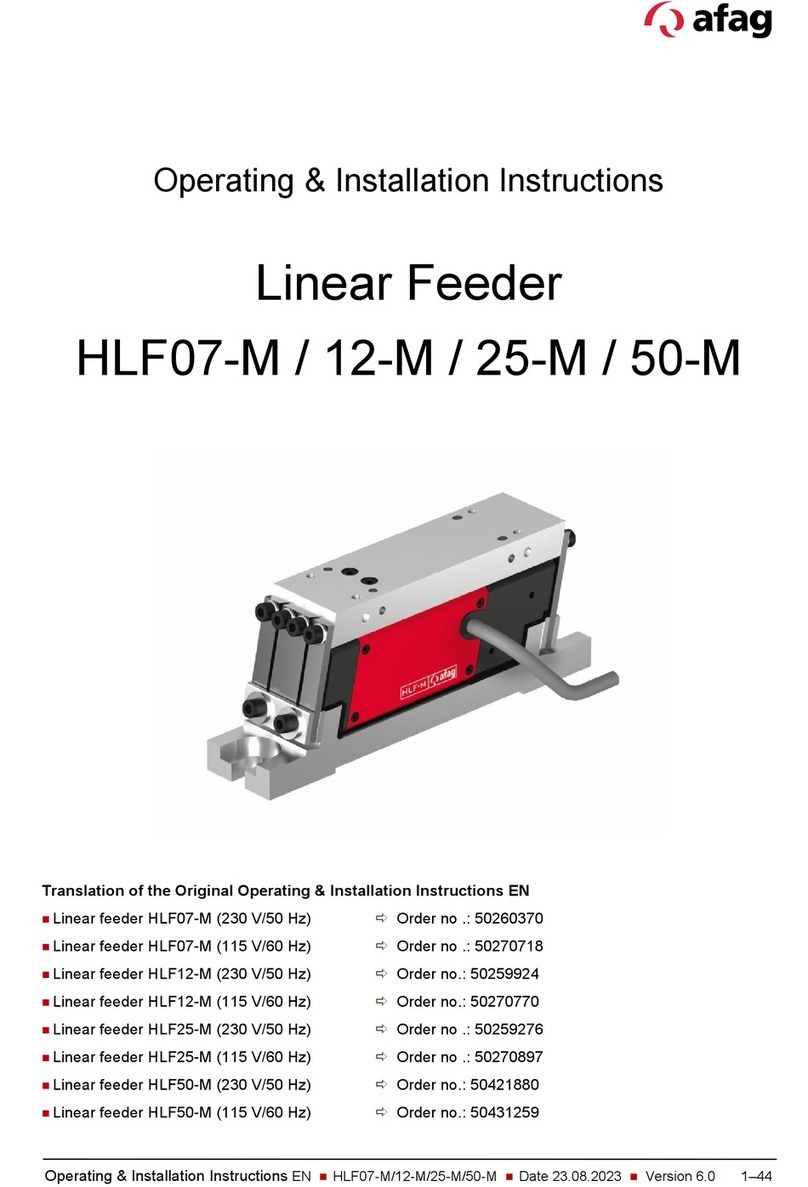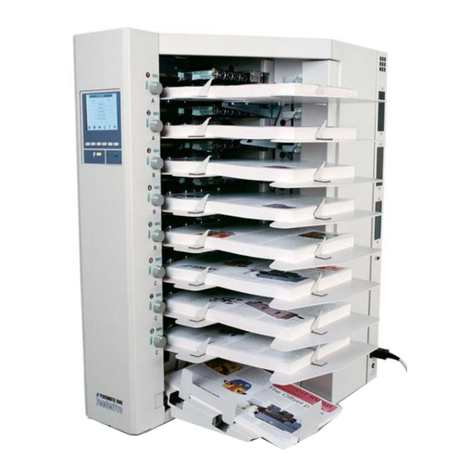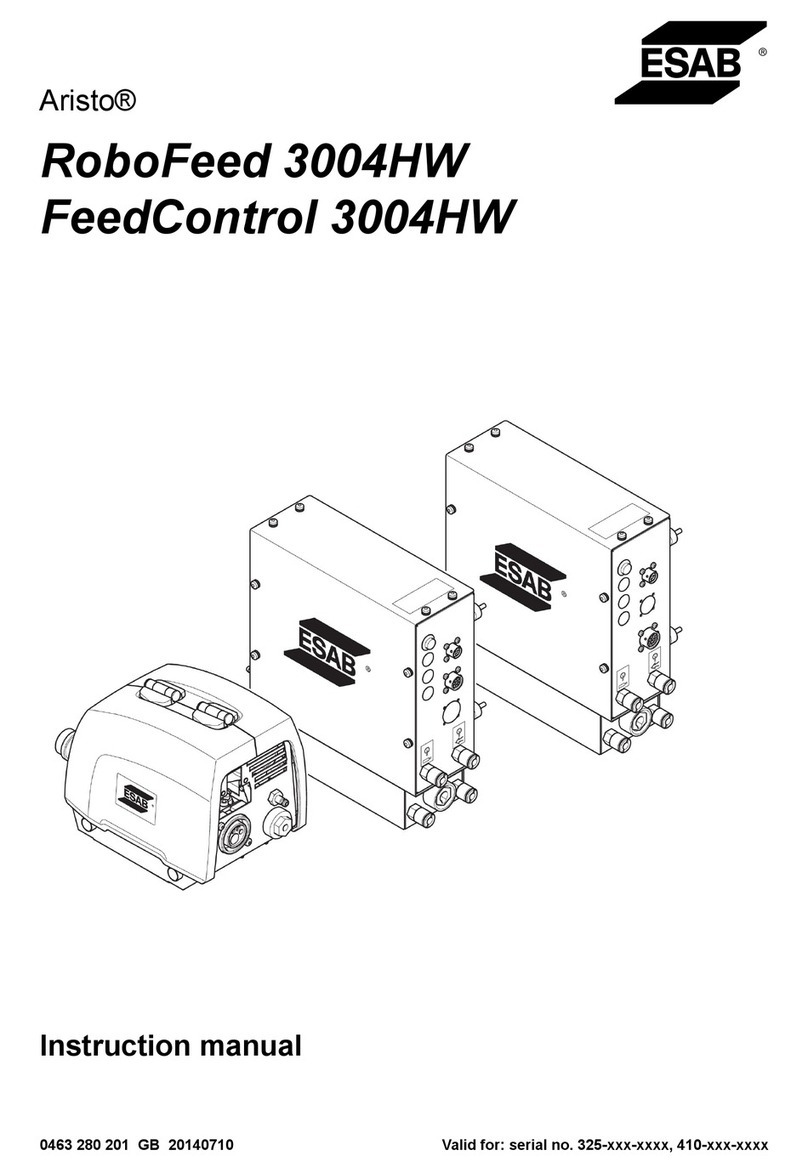MERRICK 100 VOLUMERIK Series Manual

1
SERIES 100 VOLUMERIK®
VOLUMETRIC DRY FEEDER
OPERATING AND MAINTENANCE
INSTRUCTIONS
Merrick Industries, Inc. 10 Arthur Drive Lynn Haven, FL 32444 850-265-3611 www.merrick-inc.com

2

3
TABLE OF CONTENTS
1.0 SAFETY PRECAUTIONS
1.1 DANGER FROM ELECTRICAL HAZARD 4
1.2 OPERATIONAL HAZARDS 4
1.3 SAFETY 4
2.0 PRINCIPLES OF OPERATION
2.1 MODELS 100—V1, V2 OR V3 - 04 5
2.2 MODELS 100—V1, V2 OR V3 - 06 5
3.0 FEEDER DESCRIPTION
3.1 DRIVESYSTEM 6
3.2 METERING SYSTEM 6
3.3 MOTORCONTROL 7
3.4 SEALS 7
4.0 FEEDER SETUP
4.1 INITIALSTARTUP 8
4.2 SETTING THE CURRENT LIMITS 8
4.3 ADJUSTING THE VIBRATOR 9
5.0 FEEDER MAINTENANCE 11
PROPRIETARY NOTE
The information in this manual, including technical data and copies of drawings, embodies information proprietary
to Merrick Industries, Inc. and this manual is provided to the user of equipment purchased from Merrick
Industries, Inc. for use only in operation or maintenance of such equipment. Such information in this manual is
not to be used, disclosed, copied, or reproduced in whole or part for any use other than that indicated above, or for
any other purpose detrimental to the interests of Merrick Industries, Inc. Patents owned by Merrick Industries, Inc.
have been issued or are pending on at least some of the information in this manual, and unauthorized use of this
subject matter of such patents is a violation of such patents and is prohibited.
Manual Revision 1-15-2002

4
1.0 SAFETY PRECAUTIONS
1.1 Danger from Electrical Hazard
Since this feeder is electric motor driven and includes electrical components,
the hazard of electrical shock can exist. Installation and wiring of electrical
components should be in accordance with all applicable codes.
1.2 Operational Hazards
To avoid possible personal injury, the following guidelines should be
followed:
a) Do not operate feeder with helix or with lid removed.
b) Do not operate feeder with electrical component enclosures not in place or
closed.
c) Any leakage or spillage of feed material should be cleaned up without
delay in accordance with the applicable MSDS safety guidelines and/or
plant instructions.
1.3 Safety
a) Before operating feeder or attempting to service, become familiar with
contents of the Instruction Manual.
b) Observe all precautions established by plant safety procedures.
c) Observe all feed material handling instructions provided by any
applicable MSDS guidelines.
d) Do not over paint or remove nameplates, labels or tabs.
e) If motor replacement is required, be certain that speed is the same as
original motor.
f) If feeder is to be used for other than original service, first ascertain that it
is suitable for new conditions and material compatibility.
g) Establishment of and adherence to a regular preventive maintenance
program can prevent problems by early detection of unusual conditions.
Such a program should include checking for unusual noise, overheating
and leakage.

5
2.0 PRINCIPLES OF OPERATION
2.1 Model 100-V1, V2 or V3-04
Material in the hopper flows by gravity into a rotating horizontal feed helix,
which is direct driven by a fixed speed motor and gear reducer. As the feed
helix rotates, it moves the material along the base of the hopper and out
through the discharge spout.
A built-in rate setter controls the feedrate which is manually selected by
turning the rate setting knob graduated from 3-100%.
The rate setter stops and starts the feeder motor in a repeating cycle so that
the operating time of the feeder is in direct proportion to the rate setting.
For example, if the rate is set at 50%, with a one (1) minute repeating cycle,
the feeder runs for thirty (30) seconds every minute.
2.2 Model 100-V1, V2 or V3-06
Material in the hopper flows by gravity into a rotating horizontal feed helix,
which is direct driven by a variable speed motor and gear reducer. As the
feed helix rotates, it moves the material along the base of the hopper and out
through the discharge spout.
A variable speed drive consisting of a motor and DC motor controller
determine the feed rate. Standard range with an SCR DC motor drive is 20
to 1. With a Merrick XTRA®DC drive, the range expands to 60 to 1. The
controller converts alternating current to direct current to drive the DC
motor. The DC drive as a standard is mounted as an integral part of the
feeder and consists of a 0-100% speed adjusting potentiometer with an
ON-OFF switch. If a signal conditioner is included (4-20 mA), a
REMOTE-LOCAL switch is also included. If a vibrator is required for
material conditioning, a vibrator timer with ON-OFF switch is included. A
standard unit operates on 115V 50/60Hz AC current.

6
3.0 FEEDER DESCRIPTION
The Series 100 Volumerik®feeder is a rugged screw feeder that utilizes a single auger to
meter powder or pellets to a process. The feeder is available in three sizes: 100-V1
(0.38”-1.25” diameter augers), 100-V2 (1.5”-3.0” diameter augers) and 100-V3 (3.5”-6”
diameter augers). Construction is all stainless steel and is available in 304 or 316. The
V1 is supplied standard with a 1.0 ft3hopper. The V2 is supplied standard with a 5.0 ft3
hopper. The V3 is supplied standard with a 15.0 ft3hopper. Extension hoppers are
available for all three models.
3.1 Drive System
a. The Series 100 utilizes a unique, low maintenance drive configuration.
A high quality, quill output type gear reducer is used to direct drive the
auger. This eliminates the need for pulleys, belts, couplings and flanged
bearings to support and drive the auger. The bearings internal to the
gear reducer provide the auger support. The result is a feeder with only
one external moving part: the auger. Fewer moving parts means lower
maintenance and higher reliability.
b. Power is supplied standard with a high efficiency PWM (Pulse Width
Modulated) rated DC motor. When used in conjunction with a PWM
rated drive, the higher efficiency reduces horse power lost to heat,
thereby, permitting the use of smaller motors for horse power
requirements. The smooth wave form generated by the PWM drive
greatly extends brush life.
3.2 Metering System
a. The Series 100 utilizes a unique AUGER configuration. The AUGER is
supplied in two sections. The drive end, called the STUB, extends
through the reducer quill, through the powder isolation seal and into
approximately half the length of the feeder body. The STUB never has
to be removed unless damaged. The STUB has an auger flight wound
around the outside diameter to move the material forward toward the
AUGER. The STUB also drives an OVERWIND that is welded to the
STUB. The OVERWIND, a concentric helix, acts as a bridge breaker or
agitator for feeding difficult to handle powders. The AUGER attaches
to the STUB via a left hand threaded stud. Since the OVERWIND is
attached only to the STUB, the AUGER design is simple, low cost and
easily replaceable for feeding various powders. The AUGER and
STUB may be supplied with non-stick coatings when difficult to feed
powders are metered. For some high density feed materials, the
overwind material conditioner is not used and is omitted from the
STUB. In these cases. a virbrator with timed cycle control is used the
condition the material.

7
3.3 Motor Control
a. Volumerik Feeders are supplied standard with a high efficiency PWM
(Pulse Width Modulated) DC drive that provides a 50:1 turndown at full
torque. This permits a wide range of metered material with a single size
auger. The high efficiency of the drive (1.05 form factor) extends motor
and brush life. The drive is mounted off the motor flange and can be
mounted in either of three positions in 90°increments.
b. The PWM drive is supplied standard with a 0-100% potentiometer and
START-STOP switch. A 4-20mA signal isolator for external control
can be supplied as an option and can be easily installed in the field.
VFD or timer control is also available.
3.4 Seals
a. The Series 100 utilizes a simple but highly effective seal design that
requires no maintenance. The SEAL is comprised of three rings of
pliable, rectangular Teflon rope that is kept under constant compression
via a wave spring.

8
4.0 FEEDER SET-UP
4.1 Initial Start-up
a. The feeder should arrive at your plant fully adjusted and ready to
use. Set the feeder in its production position and level the feeder
via the four adjustable feet. Make sure the motor controller is in
the STOP position and the potentiometer is set to “0” ZERO.
Then, connect power to the motor controller. Place the motor
controller in the START position and slowly increase the
potentiometer until the auger starts turning. Confirm that the auger
rotates counter-clockwise when viewing rotation from the end of
the auger protruding through the rear of the gear reducer. If
rotation is incorrect, reverse the power leads. Refer to the
electrical connection for any connection or voltage requirements.
b. If the auger rubs the spout, remove the auger (remember- left hand
threads) and inspect for straightness. The auger should be straight
within 1/32”. Straighten as required. If the auger is straight and
the auger still rubs the spout, the gear reducer mounting lugs must
be adjusted to align the auger to the centerline of the spout.
Note: A helix type auger can droop from gravity even though
straight when placed on a reference table. It is acceptable for this
type auger to rub the spout when no powder is being fed. Once
powder is fed through the auger, the rubbing will stop.
c. The motor controller is factory adjusted and ready to run. A
separate manual is enclosed for the motor controller if adjustments
or maintenance are required.
4.2 Setting the Current Limits
The Merrick XTRA DC drive has a CURRENT LIMITER feature to
help protect the auger and gear reducer from damage. Use the
following procedure to adjust.
a. Run a hopper full of feed material and discharge via the auger until
the material is just above the material conditioning helix
(overwind). Refill the feeder and place an amp meter on one leg of
the power lead to the DC drive. Start the feeder and read the
amperage draw when the feeder starts and during material
discharge. Record the maximum amperage. Now, adjust the
current limit in accordance with Figure 1 – Control Layout.

9
4.3 Adjusting the Vibrator
a. If a Vibrator is included for pre-conditioning the feed material, the
vibrator must be adjusted in both amplitude and activation time. It
is important that only the amount of vibration required to keep the
auger full is used. Over vibration can cause material packing and
cause possible feeder damage. Do not run the vibrator
continuously.
b. Vibration adjustment is by trial and error and varies with material
and humidity conditions. Start by adjusting the vibrator amplitude
to its lowest level. The vibrator is furnished with an adjusting
screw to vary the vibration amplitude. Next, adjust the ON-OFF
cycle. Two timing cycle adjustments are provided: The length of
vibration time and the time between starts and stops of the vibrator.
Each adjustment is scaled from 0-100% and represents a cycle of
2-30 minutes. First, adjust the length of vibration to
approximately 3-4 minutes. Adjust the frequency between starts
and stops to a time that equates to approximately the amount of
time to empty half the hopper. If reliable, consistent material flow
is maintained, keep this setting. If the helix starves, increase the
frequency between cycles. If this does not solve the problem,
increase the duration of vibration. If the problem remains, go back
and increase the vibrator’s amplitude to maximum.

10
A series of jumpers are located at J2. Place the jumper at the next highest current setting than
was observed when feeding material. The feeder will now trip as soon as the drive mechanism
sees an incremental current spike that exceeds this value.
4
FIGURE 1 - CONTROL LAYOUT
(Illustrates
Factory
Setting
of
Jumpers
and
Approximate
Trimpot
Settings)
STARTIS10P SWI1CI1
DOD
-INH2
~§~O"i'~Wl'
~"j
l:::!~
::~~t~
STAR
T 0
"
COM
LEOBOAAO
L----H--lh'01
STOP
D
-JOG
r"-="-tt-tH!!l
P3
--""''"'''tHI--flS'il
P2
K11!11:1
"'
""
J5
.l:ll:I)J3
TCL tiTCL
o
D
~~
~I:
:
"
10"
••
uu
@
o 0
o
Enlarged view
of
trimpots

11
5.0 FEEDER MAINTENANCE
a. The Series 100 requires virtually no maintenance. Only the lubricant in the
gear reducer must be changed at the manufacturer’s recommended interval.
Motor brushes should be checked periodically, but brush life should be greatly
extended due to the use of a PWM rated motor and PWM motor controller.
b. A complete bill of materials and assembly drawing are enclosed for identifying
components for replacement.
c. When maintenance is required, the MOTOR MUST BE ELECTRICALLY
LOCKED OUT BEFORE WORKING ON THE FEEDER. To disassemble the
feeder, remove the four knobs supporting the SPOUT and remove the spout and
gasket. Remove the AUGER by turning it clockwise (left hand thread). This is
all the disassembly required for cleaning. If further disassembly is required, the
next step is to remove the OVERWIND STUB. The STUB is held in place by
two set screws and key way at the end of the reducer quill. Loosen the set
screws and pull the STUB out of the reducer quill. Next remove the four screws
holding the gear reducer in place and remove the reducer. This will expose the
seal packing gland. The SEAL is captivated by a round retaining plate secured
with three nuts. Remove the nuts and RETAINING PLATE and the
compression WASHER and the SEALS (packing) will be exposed for removal.
d. When reassembling the feeder, reverse the procedure. Since construction is all
stainless, it is necessary to guard against galling. Before reassembling the
STUB, coat the shaft with Never-Sieze before inserting into the reducer quill.
Likewise, apply Never-Sieze to the threads on the end of the STUB before
attaching the AUGER.
e. Once the gear reducer has been removed and re-installed, alignment may be
necessary. The AUGER is aligned to the centerline of the SPOUT by adjusting
four hex stand-offs supporting the gear reducer. The reducer is aligned when
the AUGER turns freely without rubbing the SPOUT.
File: 100vol.doc
Table of contents



